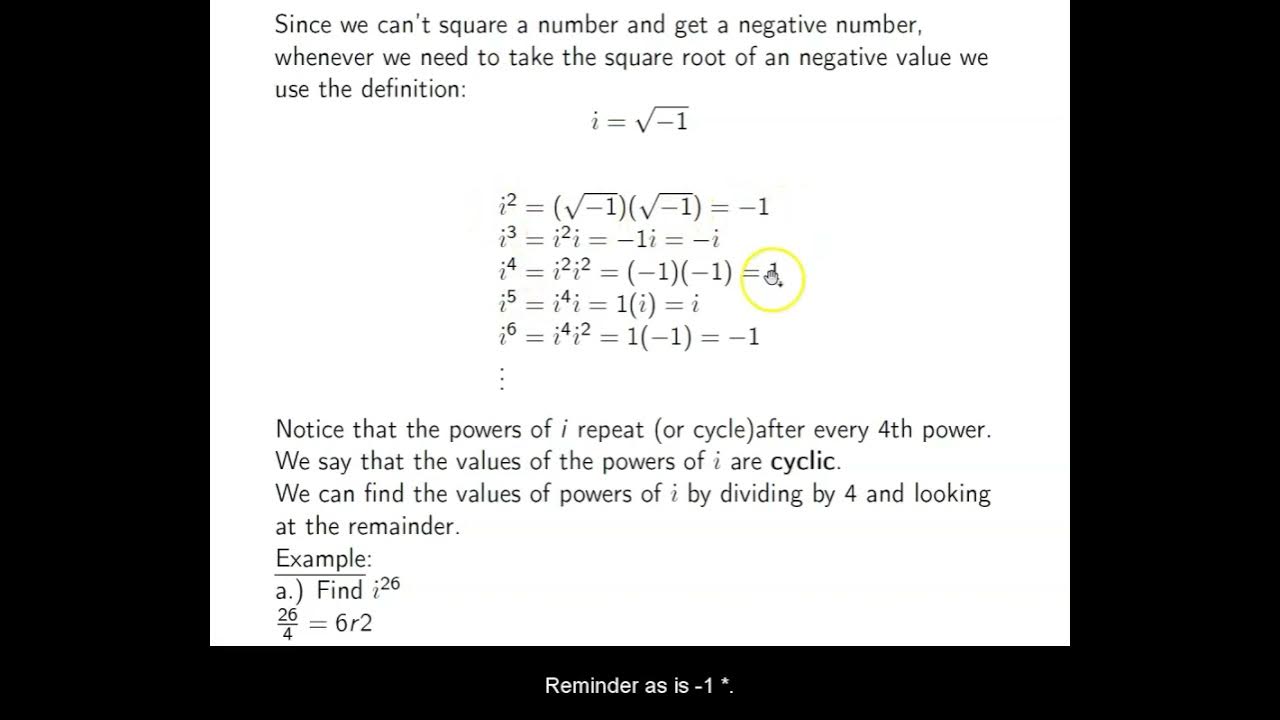What are the Types of Numbers? Real vs. Imaginary, Rational vs. Irrational
TLDRThe script provides a taxonomy of numbers, categorizing them into real and imaginary. Real numbers consist of rational and irrational numbers. Rational numbers can be represented as a ratio of integers, while irrational numbers have non-repeating, non-terminating decimals. Imaginary numbers involve the square root of negative numbers, with 'i' used to designate these. The concept of irrational numbers initially disturbed mathematicians as it challenged the notion of perfection in numbers. Irrational numbers like pi and the square root of two exist in reality through geometric concepts. The summary conveys the essence of categorizing numbers while sparking interest.
Takeaways
- 😀 There are different types of numbers like real, imaginary, rational, and irrational
- 😇 Real numbers are numbers that actually exist while imaginary numbers are square roots of negative numbers
- 🤓 Rational numbers can be written as a ratio of two integers while irrational numbers have non-repeating, non-terminating decimals
- 🧐 Examples of irrational numbers are π and √2 which have decimal values that go on forever randomly
- 🤔 Although irrational, numbers like √2 and π are real because they are related to real world objects like circles
- 😮 When ancient Greeks discovered irrational numbers, they were troubled because it disrupted their idea of perfection in numbers
- 👍🏻 Decimals that repeat forever are rational numbers since they can be written as a ratio of integers
- 😊 Fractions are rational numbers that fall between whole integer values
- 🙂 Natural numbers start from 1 while whole numbers start from 0 - both are types of integer
- 💡 After covering all types of numbers, we should understand the difference between real/imaginary and rational/irrational numbers
Q & A
What are the two main categories that all numbers can be divided into?
-All numbers can be divided into two main categories: real numbers and imaginary numbers.
How are imaginary numbers defined?
-Imaginary numbers are numbers that are defined as the square root of negative numbers. The fundamental imaginary number is 'i', which is defined as the square root of -1.
What are the two subcategories within real numbers?
-Within real numbers, there are two subcategories: rational numbers and irrational numbers.
How are rational numbers defined?
-Rational numbers are defined as any number that can be expressed as the ratio of two integers.
What are some examples of irrational numbers?
-Examples of irrational numbers include π, √2, √3 etc. These are numbers that have non-terminating and non-repeating decimals.
Can an irrational number also be a real number?
-Yes, irrational numbers are also real numbers. Even though they can't be represented exactly, irrational numbers correspond to real quantities.
What is the difference between whole numbers and natural numbers?
-Whole numbers include 0 and all the positive integers. Natural numbers include all the positive integers but exclude 0.
Can a number with non-terminating repeating decimals be a rational number?
-Yes, numbers with non-terminating but repeating decimals can be rational numbers. These can be represented as fractions, such as 1/3 = 0.333...
What does it mean when a decimal is represented with a bar over some digits?
-When there is a bar over some digits in a decimal, it means those digits repeat forever. For example 0.1̅ = 0.1111...
What happened when irrational numbers were first discovered?
-When irrational numbers were first discovered by the Ancient Greeks, it created chaos because it threatened the idea that numbers should have a divine perfection.
Outlines
😀 Introducing Types of Numbers
This paragraph introduces the topic of different types of numbers that exist. It mentions real vs imaginary numbers, rational vs irrational numbers, integers, fractions, etc. and explains how numbers can be categorized into a taxonomy.
😊 Explaining Key Types of Numbers
This paragraph provides more details on imaginary, real, rational, and irrational numbers. It gives examples like square root of negative numbers, pi, root 2. It also mentions rational numbers with repeating decimals, and sub-types like integers, whole numbers and natural numbers.
Mindmap
Keywords
💡numbers
💡real numbers
💡imaginary numbers
💡rational numbers
💡irrational numbers
💡integers
💡decimals
💡fractions
💡sqrt(2)
💡pi
Highlights
Any number you can possibly conceive of, they are all here somewhere.
Imaginary numbers are defined for taking roots of negative numbers.
Rational numbers can be expressed as the ratio of two integers.
Irrational numbers have non-repeating, non-terminating decimals.
The square root of 2 is an example of an irrational number.
Pi is another important irrational number.
Some non-terminating decimals are rational, like 1/3.
Real numbers include both rational and irrational numbers.
Imaginary numbers involve the square roots of negative numbers.
Rational numbers can be written as fractions.
Integers and whole numbers are types of rational numbers.
Fractions represent numbers between integers.
Natural numbers are integers starting from 1.
Rational and irrational numbers make up real numbers.
Check comprehension on differences between number types.
Transcripts
Browse More Related Video

A Proof That The Square Root of Two Is Irrational

Complex Numbers: Operations, Complex Conjugates, and the Linear Factorization Theorem

Add, Subtract, Multiply, Divide Imaginary & Complex Numbers - [1]

Ch. 1.6 Complex Numbers

Imaginary Numbers Are Real [Part 1: Introduction]

Finding the Domain of Functions (Precalculus - College Algebra 4)
5.0 / 5 (0 votes)
Thanks for rating: